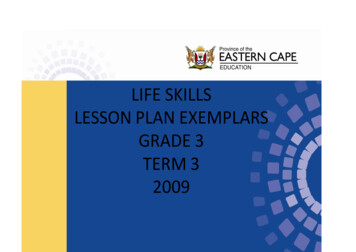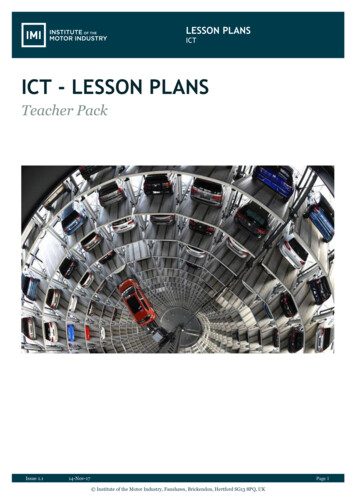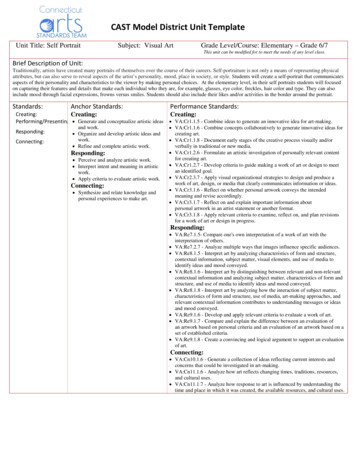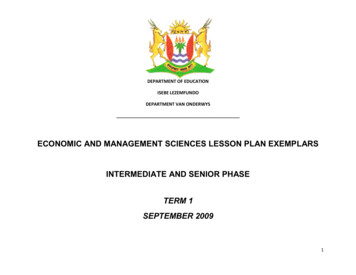
Transcription
LIFE SKILLSLESSON PLAN EXEMPLARSGRADE 3TERM 32009
TABLE OF CONTENTSCONTENTPAGESIntroduction3Overview of a Learning Programme4-7Work Schedule8-10Lesson Plans Exemplars11-27Formal Assessment Task28-292
INTRODUCTIONThe Eastern Cape Department of Education, Curriculum Chief Directorate in collaboration with the District Curriculum Advisors developed this document to supportteachers in planning for teaching, learning and assessment for effective implementation of the National Curriculum Statement in the Foundation PhaseLife Skills is one of the three Learning Programmes taught in the Foundation Phase. It deals with the holistic development of the child, socially, emotionally,personally and physically. It also provides inclusive topics or themes that are relevant to real life situation of a learner. These themes may promote literacy skillsthrough role play drama and discussions. LO4 Physical Development will also consolidate some concepts in Mathematics and promote Numeracy skillsThis document serves to assist teachers with daily teaching, learning and assessment in Life Skills for Grade 1‐3. A Work Schedule for term 3 has been developed.Integration of Assessment Standards has been done for the teachers. Planning accommodates Formal Assessment Tasks (FATs) and Learner Attainment Targets asindicated in the Draft LAT document which will be finalised soon and sent to schools. Lesson plan exemplars can be adapted and refined so that they meet the needsand the context of the learner .The resources that are indicated are a guide. Teachers are at liberty to use other relevant material.Teaching time for Life Skills is 1 hour 15 minutes daily, 6 hours 15 minutes weekly in Grade 3 according to National policy. This time allocation for Life Skills must beadhered to. All the lesson plans have been designed to cover Learning Outcomes and Assessment Standards for the third term according to the Work Schedule.Teachers are advised to use the Provincial Assessment Guidelines for exemplars of assessment tools3
GRADE 3ANNUAL OVERVIEW OF A LEARNING PROGRAMMELO1: HEALTH PROMOTIONASSESSMENT STANDARDAS 1 – Compares healthy and poor dietary habits and describesthe effects of such habits on personal health.TERM 1TERM 2TERM 3TERM 4Importance of a balancedParticipationinrecycling project.Distinguish betweenCategorise food intohealthy an unhealthygroupsFunctions of differentfood groups on thebody.Explanation of whatDiscussion of differentGrouping of wasteRecycling is.types of waste and theirproducts for recycling.Pollution and how itpossible uses.diet.foodAS 2 – Participates in a recycling project and explains howrecycling contributes to environmental health.aAffects the environment.AS 3 – Discuses myths surrounding communicable diseasesand the causes and preventions of these.Examples ofMyths surrounding somecommunicable diseasesand how they are passedcommunicable diseasesincluding HIV/AIDS.How to preventisolation of infected andaffected people throughthese myths.Eating and living withsomebody withTB/HIV/AIDS.on including HIV/AIDS.Hugging and kissing.Witchcraft.AS 4 – Identifies relevant people and their contact details toreport cases of accidents, abuse, crime, fire, illness and injury.4People in the health careand safety professions likenurses, policemen, socialworkers, traditional healers.Know them and their role insociety.People in the health careand safety professions likenurses, policemen, socialworkers, traditional healers.Know them andPlaces to go to forhelp.Knowledge of emergencynumbers like the nearestpolice station,ambulance,
GRADE 3ANNUAL OVERVIEW OF A LEARNING PROGRAMMEtheir role in society.etc.LO2: SOCIAL DEVELOPMENTAS 1 – Explain leadership qualities in the school context andparticipates in school voting.What is a leader (qualities)Explain terms associatedExplain leadership inschool context.Characteristics ofschool leader theywould vote for.Participation in a schoolvote.List some of the messagesin the anthem.Recognise andappreciate it when it issung.Singing all the words ofthe National Anthem.with voting like :-Ballotpaper Election, NominationSecret Ballot Candidate, etcAS 2 – Explains meaning of and sings the National Anthem.What is a NationalAnthem?AS 3 – Discusses the role of acceptance, giving, forgiveness,sharing in healthy social relationships.Explain how people differand how they can besimilar.Understand that peoplesometimes have a differenceof opinion about something.Importance of sharingwith others andcooperating with peoplein celebrating theHeritage Day.Importance of sharingwith others andcooperating with people.AS 4 – Tells stories of female and male role models from avariety of local cultures.Discuss male/female roleEquality of the sexes.State positive aspectsabout own role models.Women’s Day talkthroughSame career choices forName and describingclothes worn by differentExplain how food isused in certain religiousDiscuss similarities andreligious leaders.ceremoniesmodels within communities.AS 5 – Discuss diet, clothing and decorations in a variety ofreligions in S.A.Identify prominentdifferences in festivalReligious celebration intheir communities.Both men and woman.decorations used bydifferent religions.5
GRADE 3ANNUAL OVERVIEW OF A LEARNING PROGRAMMELO3: PERSONAL DEVELOPMENTAS 1 – Describes own abilities, interests and strengths.Identification of ownUnderstanding of whatPersonal interests.they can or cannot doExplaining why one likes/does not like certain(weakness vs strength).thingsIdentification of one’sstrong points.Self-assessment in terms ofwhat one can/cannot do.AS 2 – Explains why own body should be respected.Understands differentinternal and external partsof the body and how theywork.Ability to look after own bodywell, what to do, not to do.Identify forms of abuseand how they canhappen.Understanding of whatone could do in cases ofabuse (who to tell,contact person, etc).AS 3 – Explains how she/he copes with challenging emotionsincluding dealing with living with diseases and illness.Understanding of life’schallenging situations likedeath, terminal illness, etc.What to do/not to do whenliving with someone with aterminal illness like HIV/AIDSPlaces to go to for helpand support whendealing with sadness.Coping skills to help intimes of loss of sadness.AS 4 – Demonstrates assertiveness appropriate to a situation.Knowledge of what actionsto take when faced withdifferent situations.People and places of helpwhen needed.Decision making.Action plan for differentsituations.AS 5 – Identifies group work skills and applies themconsistently.Identify own role in class.Adhering to group rules.Listening attentively toothers point of view e.g.when planting treescelebrating Arbor WeekTaking responsibility andaccountability in owngroup.Performs movement toa sound in sequenceRemembers patterns ofmovement and performsLO 4: PHYSICAL DEVELOPMENT AND MOVEMENTAS.1 – Demonstrates a variety of perceptual motor skills, in6Follows simple movementPerforms movement
GRADE 3ANNUAL OVERVIEW OF A LEARNING PROGRAMME7pairs and in teams, using simple rules.rules.cooperatively.(alone, in pairs or ingroups.them.AS 2 – Performs basic movements in sequence and withrepetition, with and without equipment.Uses different body parts tomake rhythmic movements.Uses different body parts tomake rhythmic movements.Appropriate use ofequipment with bodymovements insequence.Appropriate use ofequipment with bodymovements in sequence.ASS 3 – Explores expressive movements using contrasts ofspeed, direction, body shape and position.Follows the rhythm andspeed of music whilstperforming differentmovements.Follows the rhythm andspeed of music whilstperforming differentmovements.Follows movementsand sequencingfocusing on speed,rhythm direction andposition.Follows movements andsequencing focusing onspeed, rhythm directionand position.ASS 4 – Participates in play and describes its effects on thebody.Identify and play gamesthey enjoy playing andexplain why they like them.Play and explain importanceof participating in play.Play and explain effectsof physical activity onthe body.Play a variety of gameswith rhythm, speed etc.Linking it to AS 1, 2 AND3 (ABOVE)
LIFE SKILLS: GRADE 3 WORK SCHEDULE TERM: 3WEEK 1WEEK 2 ( OUR COUNTRY)WEEK 3 (HEALTHY LIVING)WEEK 4(COMMUNICABLE DISEASES)WEEK 5 (SAFETY)(CONSOLIDATION OFTERM 2 WORK)LO 2 AS 2Explains meaning of andsings the National AnthemCONCEPTList some of the messagesin the National Anthem.LO 2 AS 2Explain the meaning of andsings the National AnthemCONCEPTRecognise, appreciatesand behaves when it issung.INTEGRATIONGEO: LO 1 AS 2HL: LO 2 AS 8MATHS: LO 1 ASRESOURCESMap, posters with theNational Anthem, taperecorderASSESSMENTSTRATEGIESFORMSOral, practicaldemonstrationTOOLSChecklist, observationsheet, rating scale,worksheetMETHODSTeacher, self, peer andgroupLO 3 AS 2Explains why own body shouldbe respectedCONCEPTIdentify forms of abuse and howthey can happen. (WOMEN’SDAY TALK THROUGH)INTEGRATIONHL: LO1 AS 6LO2 AS 5.7RESOURCESPictures from heath centresRecorded articlePuppetsMagazinesASSESSMENT STRATEGIESFORMSOralWrittenTOOLSRating ScaleObservation SheetMETHODTeacher, Self, Peer and GroupLO 1 AS 3Discusses myths surroundingcommunicable diseases and thecauses and prevention of theseCONCEPTHow to prevent isolation of infectedand affected people thought thesemyths.LO 3 AS 3Explains how she/he copes withchallenging emotions including dealingwith living with diseases and illnessCONCEPTPlaces to go to for help and supportwhen dealing with sadness.LO3 AS 4Demonstrates assertivenessappropriate to a situationCONCEPTSDecision makingINTEGRATION ACROSSHL: LO 1 AS 6LO2 AS 5.7RESOURCESHuman Resources, workbooks,picturesASSESSMENT STRATEGIESFORMSOral & written responsesPractical demonstrationsTOOLSChecklist Rating ScaleMETHODSTeacher, GroupLO 1 AS 4Identifies relevant people and theircontact details to report cases ofaccidents, abuse, crime, fire, illnessand injury.CONCEPTKnowledge of emergency numberslike the nearest police station,ambulance etc.INTEGRATION ACROSSHL LO1 AS:1RESOURCESHuman Resources Picturese.g. NurseWorkbooksASSESSMENT STRATEGIESFORMOral & writtenTOOLSWorksheet, checklist, observationbookMETHODSTeacher, Peer, Group8
WEEK 6 (KEEPINGHEALTHY)LO 4 AS 4Participates in play anddescribes its effect on thebodyCONCEPTPlay and explain theimportance of participatingin playLO 4 AS 3Explores expressivemovements using contrasts of speed, direction, bodyshape and position.CONCEPTFollowing movements andsequencing focussing onspeed, rhythm, directionand positionLO 4 AS 2Performs basic movementsin sequence and withrepetition with and withoutequipmentCONCEPTAppropriate use ofequipment with bodymovements in sequenceINTERGRATION WITHINLO 1 AS 1Compares healthy and poordietary habits anddescribes the effects ofsuch habits on personalhealthCONCEPT9WEEK 7 ( WORLDAROUND ME)LO 3 AS 1Describes own abilities,interests and strengths.CONCEPTSIdentification of one’sstrong pointsLO 2 AS 4Tells stories of female andmale role models from avariety of local cultures.CONCEPTState positive aspectsabout own role model.Women’s day talk throughLO 2 AS 1Explain leadership qualitiesin the school context andparticipates in schoolvoting.CONCEPTExplain leadership inschool contextExplain his/her school’sleadership structureCharacteristics of schoolleader they would vote forINTEGRATION ACROSSMaths LO 4 AS:3.1A/C Visual Art LO 1 AS:1.2&2SS GEO LO 1 AS:1FAL LO 2 AS:10HL LO4 AS 4.2; LO 1 AS 6;LO 2 AS 5.7RESOURCESWEEK 8 (ENVIRONMENT)WEEK 9 (HERITAGE)LO 1 AS 2Participates in a recyclingproject and explain howrecycling contributes toenvironmental health.CONCEPTGrouping of waste products forrecyclingLO 4 AS 1Demonstrates a variety ofperceptual motor skills in pairsand in teams using simple rulesCONCEPTPerforms movement to a soundin sequence alone , in pairs or ingroupsLO 3 AS 5Identifies group work skills andapplies them consistently.CONCEPTListening attentively to otherspoint of view e.g. CelebratingArbor Week by planting treesINTEGRATION ACROSSEMS LO 1 AS 1MATHS LO 5 AS:1N/S LO 1 AS 2.1TECH.LO1 AS3.1RESOURCESPosters, waste materialASSESSMENT STRATEGIESFORMOral, practical,TOOLChecklistLO 2 AS 3Discusses the role of acceptance,giving, forgiveness, sharing in healthysocial relationships.CONCEPTImportance of sharing with others andcooperating with people and alsocelebrating Heritage Day.INTEGRATION ACROSSMaths LO4 AS:3.1A/C Visual Art AS:2RESOURCESCalendar posters, decorationsASSESSMENT STRATEGIESFORMSOralWrittenPractical er, GroupWEEK 10 (HERITAGECONTINUES)LO 2 AS 5Discuss diet, clothing anddecorations in a variety of religions inS.A.CONCEPTExplain how food is used in certainreligious ceremonies.INTEGRATION ACROSSMaths LO4 AS:3.1A/C Visual Art AS:2RESOURCESCalendar posters, decorationsASSESSMENT STRATEGIESFORMSOralWrittenPractical er, Group
Functions of different foodgroups in the bodyINTEGRATION ACROSSMaths LO5 AS:1 & 2HL LO5 AS:4.2RESOURCESPapers, crayons, pencils,posters, magazinesASSESSMENTSTRATEGIESFORMSOral, written, ry Books(Prominentfigure), calendar, posters,crayons, paint, magazines,puzzles, picturesASSESSMENTSTRATEGIESFORMSOral , picturesFORMOral, writtenTOOLRating Scale, checklistMETHODTeacher, self, groupMETHODSelf, peer, teacher, group
LESSON PLAN EXEMPLAR WEEK 2TERM 3DURATION: WEEKSLearning Outcomesand AssessmentStandardsLO 2 AS 2Explains meaning of andsings the National AnthemINTEGRATIONSS:HISTORY:LO2 AS 3GEO:LO 1 AS 2ARTS & CULTURE LO 1AS 3HL: LO 2 AS 7LO 3 AS 111LEARNING PROGRAMME:DAILY:1 Hour 15 minLIFE SKILLSWEEKLY: 6 Hours 15 minGRADE 3CONTEXT: OUR COUNTRYLearning Activities1. Give the learners different photographs that show an area of atown from books, magazine or newspapers.2. In groups the learners should look and name the places oranything that they see in their photographs.3. Groups name places/things that are common in theirphotographs.4. Give them a map that clearly shows the provinces and maintowns in South Africa.5. Discuss these with the learners by asking simple questions like:(a) Where on the map is their town or area?(b) How many provinces do they see in the map?(c) Which province do they live in?(d) What is the closest city to their town?(e) Which provinces are on the borders of their province?(f) Which provinces are far from the sea?6. Explain that when all the 9 provinces are put together they arecalled South Africa (our country)7. Explain to learners that most countries have symbols like anational flag.8. Learners brainstorm the South African flag colours and theirmeaning.Details ofAssessmentFORMALForm :WrittenMethod:EducatorTool ,map of SouthAfrica, posterof a NationalAnthem
9. They should draw and colour the South African flag.10. Ask them the following questions:(a) Do they know the South African Anthem? If so what is it?e.g. It is the song that every South African should know andbe able to sing, it is a prayer for God’s blessings on our landand all its people, it was written by 2 Authors, verses wereadded by S.E.K. Mqhayi and was published in 1927, it wasadopted by the Parliament in 1995.(b) How many languages does the Anthem have and what arethey? e.g. 5 i.e. IsiXhosa. IsiZulu, seSotho, Afrikaans andEnglish(c) What should we do when we sing it? e.g. We should allstand still to honour our country.(d) When do we sing it? e.g. We sing this on all specialoccasions.11. Let the learners practice singing the National Anthem standing atattention whilst doing so.12. Put the poster with the Anthem on the chalkboard.13. Briefly tell them about the 2 writers of this Anthem.e.g. Enoch Sontonga a professional teacher born in Uitenhage,inthe Eastern Cape in 1873 and died in 1905 and C.J.Langenhoven a lawyer born in Ladysmith in the Eastern Cape in1873 and died in 1932, verses were added by S.E.K. Mqhayiand published in 192714. Read the Anthem with the learners15. Give and discuss the meaning of the words and/orPhrases in the Anthem.ACTIVITY 1 FOR FORMAL ASSESSMENT TASK1. Name all the colours on the South African flag2. What is the National Anthem? Give any 23. What is the meaning of the words Nkosi Sikelel’ iAfrika4. Who are the writers of our National Anthem?5. Do you think that our National Anthem brings the cultures of12
South Africa together? Support your statement.6. Complete the following first sentences:Uit die blou.Nkosi sike.Sounds the call.BARRIERS:REFLECTIONS:13
LESSON PLAN EXEMPLAR WEEK 3TERM 3DURATION:WEEKSLearning Outcomesand AssessmentStandardsLO 3 AS 2Explains why ownbody should berespectedMATHS LO 5 AS 2Sorts, orders andorganizes own andsupplied data by oneor more attributes fora particular reason.FAL LO 5 AS 2.1Uses language forthinking and problemsolving comparesthings critically14LEARNING PROGRAMME:DAILY:1 Hour 15 minWEEKLY: 6 Hours 15 minLIFE SKILLSGRADE 3CONTEXT: HEALTHY LIVINGLearning Activities1. Discuss school rules e.g. shirts must be tucked in, no coloured nailsor hair, no bullying etc.2. In groups the learners discuss ‘appropriate’ and ‘inappropriate’dress codes. e.g. what they think about each behaviour and how dothey feel about each.3. Learners should give reasons for their answers.4. Discuss with the learners the meaning of the words ‘respect’ and‘self respect’, i.e. , is Respect is treating others nicely, is knowingthat others are valuable too, it is caring for others, their possessionsand the environment. ‘Self respect’ is liking yourself, is feelinggood about self, is looking after and caring for your body and yourpossessions and is knowing that you are lovable and unique.5. Create and tell the learners a moral story about an animal or aperson that once found itself or herself/himself in a dangeroussituation.6. Encourage discussion about their feelings in situations that could bedangerous by asking them questions based on the story told like:(a) How do you think the animal/person felt in that situation?(b) Do animals/people know when danger threatens? How?(c) What will one do about it?(d) Do the learners know when they are in a situation that is notDetails g rs,Scissors,glue,crayons
good for them?(e) Have they ever been in such a situation?(f) How did they feel?(g) Have they ever said ‘yes’ to someone just because it was easierthan to say ‘no’(h) Were they too shy to say how they felt?7. Tell the learners that they should never feel guilty or ashamed to tellor show people that they do not like what is being done to them8. Give them different ways in which they can react in differentsituations to put where relevant. e.g. not allow other people to hurtyou, find it difficult to say ‘no’, be aggressive to scare others, firmlyand politely say ‘no’, hurt other people to protect yourself, feel afraidand easily feel threatened, respect other people and not abusethem, give reasons for saying ‘no’When you respect and feelgood about yourselfWhen you do not feel goodabout yourselfACTIVITY 2 FORMAL ASSESSMENT TASK 1Divide the learners into groups.Each group should be creative and make a poster with slogans andpictures illustrating the issue of abuse e.g. NO, DON’T TOUCH ME, IHAVE A RIGHT TO SAY NO etc.These posters should be displayed at a certain relevant point at theschool where everyone could come across them.BARRIERS:REFLECTIONS:15
LESSON PLAN EXEMPLAR WEEK 4TERM 3DURATION: WEEKSLearning Outcomesand AssessmentStandardsLO 1 AS 3Discusses mythssurroundingcommunicablediseases and thecauses andpreventions of theseINTEGRATIONWITHINLO 3 AS 4Demonstratesassertivenessappropriate to asituation16LEARNING PROGRAMME:DAILY:1 Hour 15 minLIFE SKILLSWEEKLY: 6 Hours 15 minGRADE 3CONTEXT: COMMUNICABLE DISEASESLearning Activities1. Ask learners questions such as:(a) Have you been sick before?(b) Who of you had been immunized? If so on what?2. Discuss a picture of community workers involved with children’swelfare. e.g. What do they see on the picture? What role do thefollowing: parents, nurses, doctors etc. play in the children’swelfare and how do they do that?3. Create and tell the learners a moral stories about communicabledisease like HIV, T.B., CHOLERA etc e.g.(a) A story about an HIV, T.B. and Cholera infected child thather friends never wanted to play with because they thoughtthat they will be infected.(b) Conclude the story by ensuring them that it is only when theinfected has a cut and his/her blood gets into contact withanother with an open wound that they get infected.(c) Tell them more about other myths. e.g. witchcraft4. Ask learners questions such as:(a) What was the story about?(b) What did the story teach us?(c) Did you like the story? If so why? If not why?Details PeerGroupSelfTOOLSChecklistRating scaleResourcesMagazines,picture cuts,worksheets,moral story
(d) Write 3 short sentences about the story.ACTIVITY 3 FORMAL ASSESSMENT TASK 15. Learners should answer the following statements with either“yes” or “no” in their answer books:(a) You can become infected by touching an infected friend(b) A mosquito can give you the HIV virus(c) When you bath in the same bath with an infected person, youcan get the HIV virus(d) When sharing a syringe with an infected personBARRIERS:REFLECTIONS:17
LESSON PLAN EXEMPLAR WEEK 5TERM 2DURATION: WEEKLearning Outcomesand AssessmentStandardsLO1: AS 4 – Identifiesrelevant people andtheir contact details toreport cases ofaccidents, abuse, crime,fire, illness and injury.INTEGRATIONHLLO1 AS1Listenattentively and responds to extended sequenceof instructionsappropriate to thelearners levelLO2 AS5 Contributes togroup and classdiscussionsLO3 AS1 Reads forinformationLO4 AS7.2 Completes awriting task within a settimeArt &CultureLO2 DramaWorks with others whenexploring situations in18LEARNING PROGRAMME:DAILY:1 Hour 15 min DailyLIFE SKILLSGRADE 3WEEKLY: 6 Hours 15 minLearning Activities1. Divide your learners into groups2. Groups are given different situations to discuss aboute.g.an accidentA house on fireA sick person/a childAn old woman who is living aloneSomeone who is robbedAn abused person3. Give them leading questions if necessary e.g.What can you do to assist that person?To whom can you report the case?Where can you report the case?4. Let them report back to the class5. Draw a blank table on the board( write only headings) askthe learners to help you fill the table6.Where doWhat doHow doPeoplethey workthey drivewho helpthey helpusus7. Explain to the learners the importance of having anemergency telephone number list ready at school and atCONTEXT: SAFETYDetails ofAssessmentINFORMALFormOral practicalwrittenMethod: EducatorTool :RubricChecklistResourcesTelephone DirectoryPictures ofaccidents, crimeSmall books withemergency listPictures with peoplePolicemanNursesTraffic officerFire fightersDoctorsSocial workers
roleBARRIERS:REFLECTIONS:19home in the case of emergency8. Divide the learners into groups of 4, give each group alocal telephone directory9. Show them the emergency pages in front of thetelephone directory10. Each group member should then compile his or her ownemergency telephone list to take home11. Make sure learners include their personal numbers onthe list for example: mother’s cell phone number12. Get learners to memorise the 10111 emergencytelephone number13. Group of learners act different scenarios e.g. a girl who isbeen robbed coming from school, an accident on the wayto school
LESSON PLAN EXEMPLAR WEEK 6TERM 3LEARNING PROGRAMME:DURATION: WEEKSDAILY:1 Hour 15 min DailyLearning Outcomesand AssessmentStandardsLO 4 AS 4Participates in playand describes itseffects on the body.LO 4 AS 2Performs basicmovements insequence and withrepetition, with andwithout equipment.LO 4 AS 3Explores expressivemovements usingcontrast of speed,direction, body, shapeand positionLO 4 AS 1Demonstrates avariety of perceptualmotor skills, in pairsand in teams using20LIFE SKILLSWEEKLY: 6 Hours 15 minGRADE 3CONTEXT: KEEPING HEALTHYLearning Activities1. Divide the class into groups2. Give each group a picture cut of a healthy looking person frommagazines3. They discuss the picture by answering the following questions: (a)What does a fit and a healthy person look like? (b)What do people doto stay fit and healthy?4. Give groups time to think of suggestions about the questions and towrite their ideas in their books.5. Discuss their ideas6. Ask the learners about what they understand of exercise.7. Let them have a discussion on the importance of exercising.8. Ask the learners to take note of how they are feeling today9. Let them discuss their findings in groups.10. Learners should take turns pretending to play a sport or a game.11. The rest of the group should guess what sport or game is beingdemonstrated.12. Discuss what the learners have had for breakfast and how importantthis meal is to their wellbeing13. Ask what they have brought for lunch, they need some sort of starchand some protein at each meal to keep them going, fruit gives themenergyDetails stRating scaleResourcesMagazines,picturecuts, taperecorder,paperplates,scissors,pritt/glue
simple rules.INTEGRATIONLO 1 AS 1Compares healthyand poor dietaryhabits and describesthe effects of suchhabits on personalhealth.A/C LO 1 AS 5Use skills ofobservation, imitationand exaggeration tocreate character andmood in dramatic playand exerciseFAL LO 1 AS 4Shows understandingof a sequence ofinstructions byfollowing themcorrectlyBARRIERS:REFLECTIONS:2114. Give the learners magazines where they are going to cut differenttypes of healthy food15. Let them paste these on their paper plates and present them to thegroup.ACTIVITY 4 FORMAL ASSESSMENT TASK 1-Let them listen to the music of your choice.-Allow them to move creatively and freely in pairs to the music creatingtheir own movements, steps and sequences.-Join two pairs together so that there are 4 learners in a group.-One pair to teach the other their movements and vice versa.-Allow join other groups together to have more learners and moremovements.-Learners should now create own sequence in groups-Allow the learners to move freely for 5 minutes per groups doingdifferent movements in sequence.-Other groups should assess and evaluate the movements of the groupon stage-Allow them to stop the movement and discuss how they feel e.g. tired,thirsty, legs with cramps, breathless, enjoying the activity etc-Let them settle down.
LESSON PLAN EXEMPLAR WEEK 7TERM 2DURATION: WEEKAROUND MELearning Outcomesand AssessmentStandardsLO3 AS1 Describe ownabilities, interest andstrengthsConceptIdentification of one’sstrong pointsIntegrationWithinLO2 AS4 Tells stories offemale and male rolemodels from a variety oflocal culturesIntegrationAcrossHL LO2 AS5 Talksabout a picture,photograph or objectMaths LO 4 AS:3.1A/C Visual Art LO 1AS:1.2 & 222LEARNING PROGRAMME:DAILY:1 Hour 15 min DailyLIFE SKILLSGRADE 3WEEKLY: 6 Hours 15 minLearning Activities1. Explain to the learners the word ability. It is somethingthat your body can do like running etc2. Let learners discuss their abilities with friends next tothem, they make an outline drawing of themselves andwrite on the outline all their abilities e.g. good listener,hardworking3. Explain the word strength.( A strength is something youare good at doing)4. Learners think about the special things that they are goodat. They talk about their strengths to other learners5. Each learner is given a readymade box6. They write their strengths on all the sides7. They decorate their boxes and place them whereeveryone can see it8. Let each learner write down his/her role model(at homeand school) and tells the class why is that person his /herrole model .Some will mention their mothers and teachers9. Let them talk about their role model’s strengths andabilities10. Discuss a community member who has brought positivechange in the community e.g. feeding the poor, educatingpeople about HIV and AidsCONTEXT: WORLDDetails GroupTool :RubricChecklistResourcesPencil crayonsA4 papersMagazinesNews papers
SS GEO LO 1 AS:1FAL LO 2 AS:10HL LO4 AS 4.2; LO 1 AS6;BARRIERS:REFLECTIONS:2311. Inform the learners briefly about the apartheid era andwhat it did to people of S.A mention the names of peoplelike Nelson Mandela, Steve Bike, Chris Hani, etc12. Let the learners work in groups and find informationabout these people and talk about how they made ourcountry a better place for all13. Ask a learner to choose a personality, go and researchabout him/her and their contribution to S.A and return toclass and present a poem, praise poem or act about thatperson14. They look for their role models on magazines,newspapers, or other media and write about them15. Encourage them to read and discuss the advert showingunderstanding of what they are reading
LESSON PLAN EXEMPLAR WEEK 8TERM 3LEARNING PROGRAMME:DURATION: WEEKSLearning Outcomesand AssessmentStandardsLO 1 AS 2Participates in arecycling project andexplains howrecycling contributesto environmentalhealthINTEGRATIONWITHINLO 3 AS 5Identifies group workskills and appliesthem consistentlyINTEGRATIONACROSSMaths LO 1 AS 5NS LO 1 AS 2.1FAL LO1 AS 124LIFE SKILLSGRADE 3CONTEXT: ENVIRONMENTLearning Activities1. Discuss a picture with a heap of litter by asking questions like:(a) Is this healthy? Why?(b) What are the things that you see in the picture?(c) Let the learners categorize these according to the following:breakables, plastic bags and bottles, peels, cans, papers, eggboxes etc.2. Encourage discussion by asking questions such as:(a) What is
All the lesson plans have been designed to cover Learning Outcomes and Assessment Standards for the third term according to the Work Schedule. Teachers are advised to use the Provincial Assessment Guidelines for exemplars of assessment tools . Eating and living with . somebody with : TB/HIV/AIDS. Hugging a










